
Editor’s note: This story contains mentions of suicide.
On an April afternoon, eight medical professionals sat in a University of Colorado conference room with pens and notecards. Their task: Write about a moment of profound change. After five minutes of scribbling, the facilitator asked if anyone wanted to share. Anya Beebe, fighting back tears, volunteered. “One patient told me, ‘It took facing death for me to want to live,’” she said. “Those high-intensity moments tend to stay with me.”
Beebe is a licensed counselor who treats children with suicidal ideation and extreme eating disorders. But in that room, for 22 weeks, she was the one being heard.
At Colorado Resiliency Arts Lab (CORAL), a University of Colorado School of Medicine research initiative, Beebe was encouraged to express her intense work experiences through writing. While Beebe has long understood that frequently facing pain and death has forced her to compartmentalize her feelings, she didn’t know what to do about it until now. “The words that patients share live within me,” she said. “Sometimes I wake up in the middle of the night with that buildup if I haven’t released them.”
CORAL was launched in 2020 to treat health care worker anxiety, burnout and depression by carving out a protected space during the workday where health care professionals can process their workplace distress. Participants take a 90-minute art therapy class once a week for 12 weeks — either music, dance, visual arts or writing — to address what Dr. Marc Moss, a pulmonary critical care doctor and CORAL’s research lead, described as the unfortunate byproduct of witnessing trauma and tragedy in the workplace.
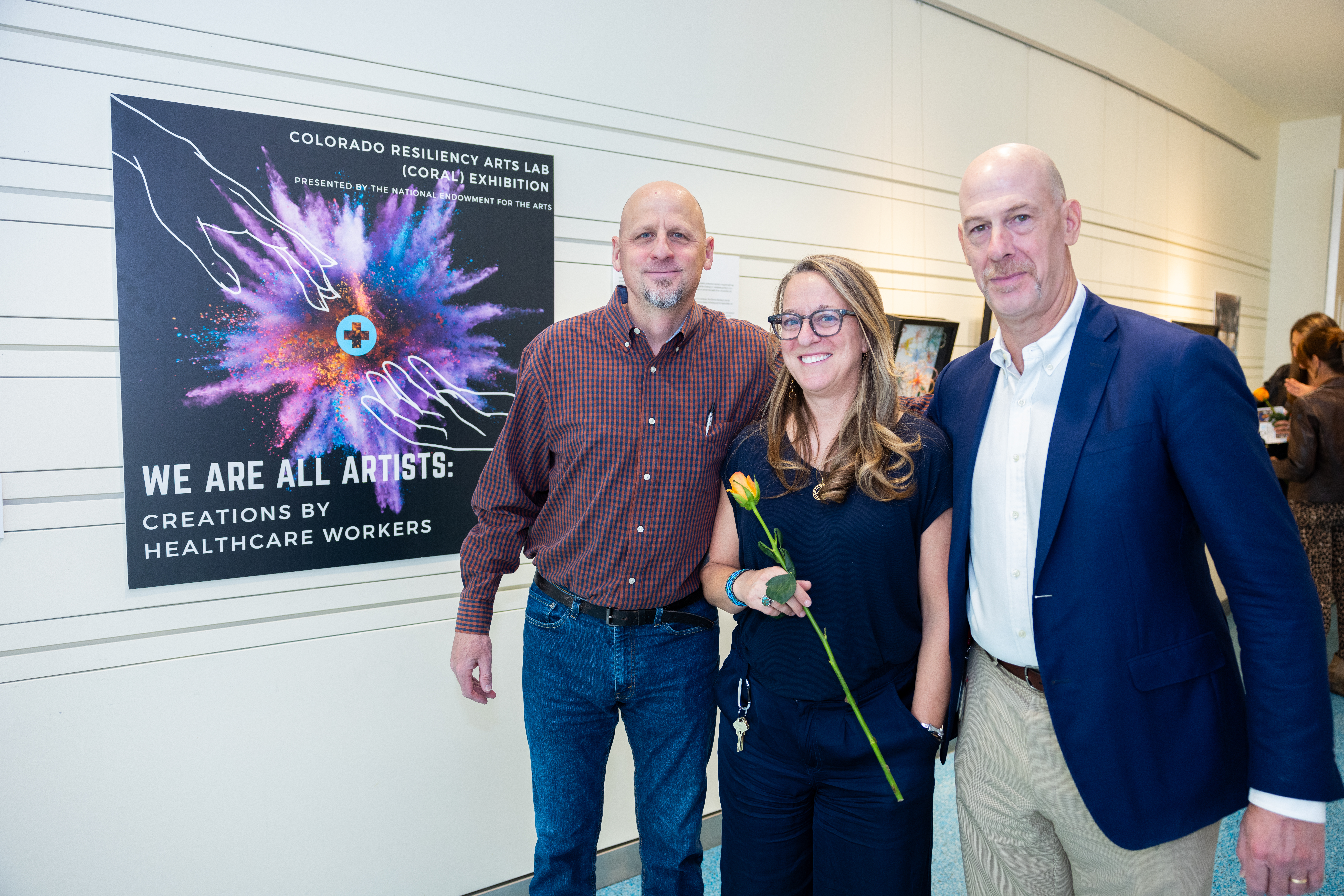
“ICU nurses and doctors watch people tragically die daily,” Moss said. “These aren’t normal experiences. They’re similar to what people sometimes see in war settings.”
The results so far show promise: CORAL participants have shown a 36% reduction in symptoms of depression, a 28% reduction in anxiety, a 26% reduction in post-traumatic stress disorder and a 12% reduction in burnout. Since 2020, CORAL has treated over 350 health care workers across seven groups and has expanded to different campuses across the University of Colorado hospital system.
Amanda Messinger, a spring 2023 writing participant and an assistant professor of pediatric pulmonary at the University of Colorado School of Medicine, said it was powerful seeing her co-workers be vulnerable with one another. “Connecting our non-medicine identities to share our roles inside and outside of work was transformative,” she said. “My writing practice became a stress release valve that I’ve continued since last year.”
CORAL’s goal is to destigmatize discussions around how much health care workers are struggling — and to give them tools to do something about it. “I don’t think of burnout and psychological distress in health care professionals as a mental health issue,” Moss said. “I think of it as an occupational health problem.”
How art can help process trauma and create connection
On a Thursday afternoon in May, the visual arts group was entering Phase 2 of the program: vulnerability. After a guided meditation where the participants were encouraged to visualize a calming place and home in on their five senses, they rummaged through their plastic bins to take out their sketchbook, watercolor paints and pastels. After a 30-minute free-draw, a few volunteered to share their pieces. One participant whose patient had died by suicide that week painted a lone flower sitting under thick streaks of gold across a starlit sky. Another painted abstract swirls of water draining at her feet, representing how the shower had become her safe space to wash off the horror of the workday before rejoining her family in the evening. Classmates nodded in agreement. A few responded with their own pandemic shower rituals.
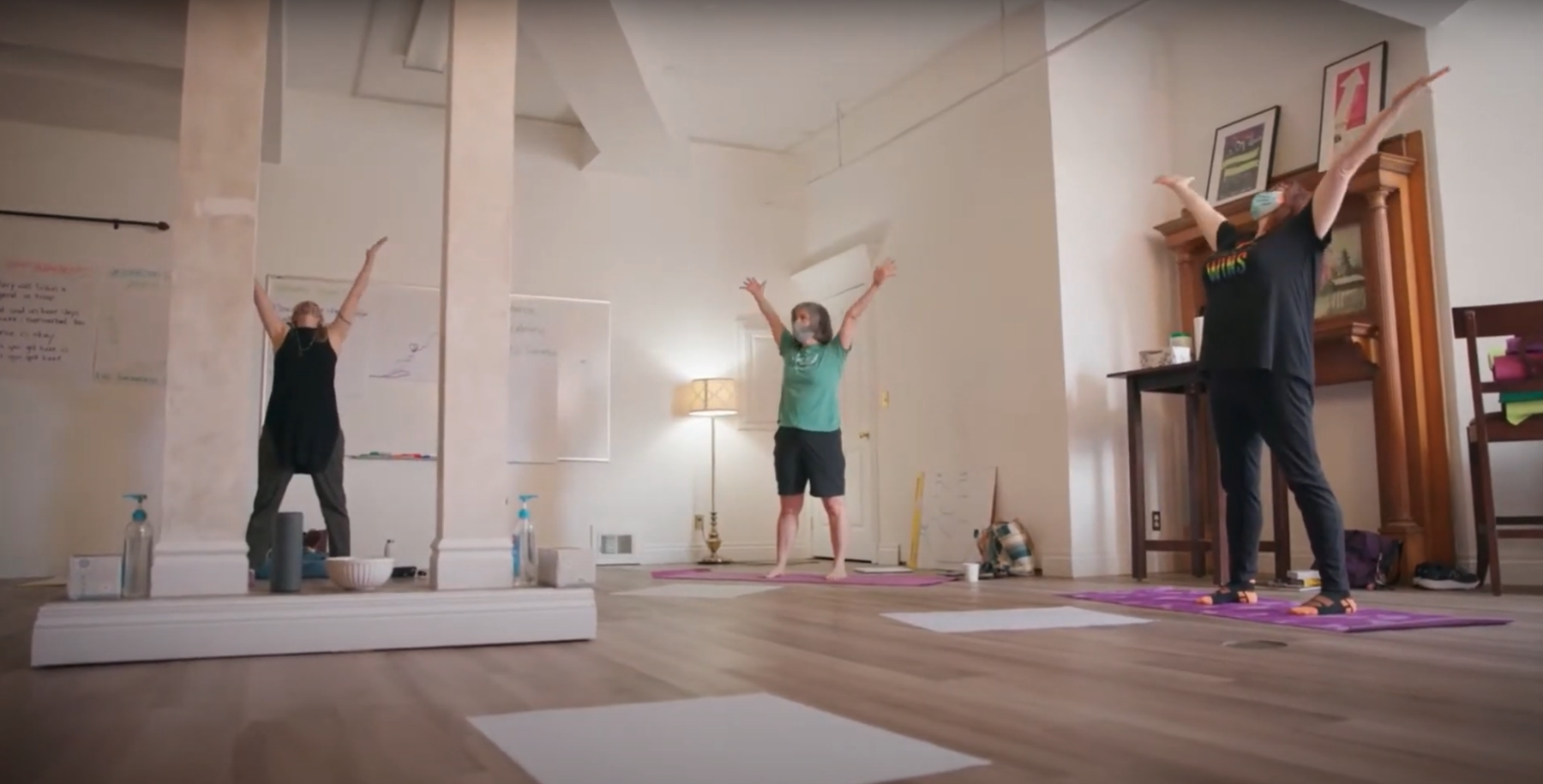
Stacey Coss, a pediatric emergency nurse who participated in two 12-week sessions, said music and writing led her to confront difficult memories she had repressed. Coss already had buried trauma from treating patients during the night of the 2012 Aurora, Colorado, theater shooting. Then came the Covid-19 pandemic, and with it, the dread and fear of not knowing if things would get better or how they would end. Coss said that joining CORAL gave her the clarity she needed to make a life change. “I confronted the hard truth that I could love my job but it wasn’t good for me,” she said. “I left the emergency department to become a nurse educator.”
Since 2007, Moss has raised the alarm about high distress rates among the intensive care unit nurses he worked with. He said no one paid attention to his research, though, until he received a 2018 grant from the National Endowment for the Arts to bring creative arts therapy to health care workers. Then, the pandemic hit just before CORAL’s launch. Though the health care industry already had high rates of turnover — nurse turnover rates were at 17% in 2018 — the pandemic brought increased risk of health care worker illness and death, especially among Fliipino nurses. Health care workers exiting the industry rose by 8% from 2018 to 2021.
When they started CORAL, Moss and his research collaborators — Katherine Reed, manager of the creative arts therapy at Children’s Hospital Colorado and Michael Henry, executive director of the Lighthouse Writers Workshop in Denver — knew it would be crucial for participants to trust one another unequivocally, so they developed a set of guidelines: Facilitators would help participants build a sense of safety during the first four weeks, dive into their unresolved trauma in weeks five to eight and deepen their connections to create a final group art project during the last four weeks.
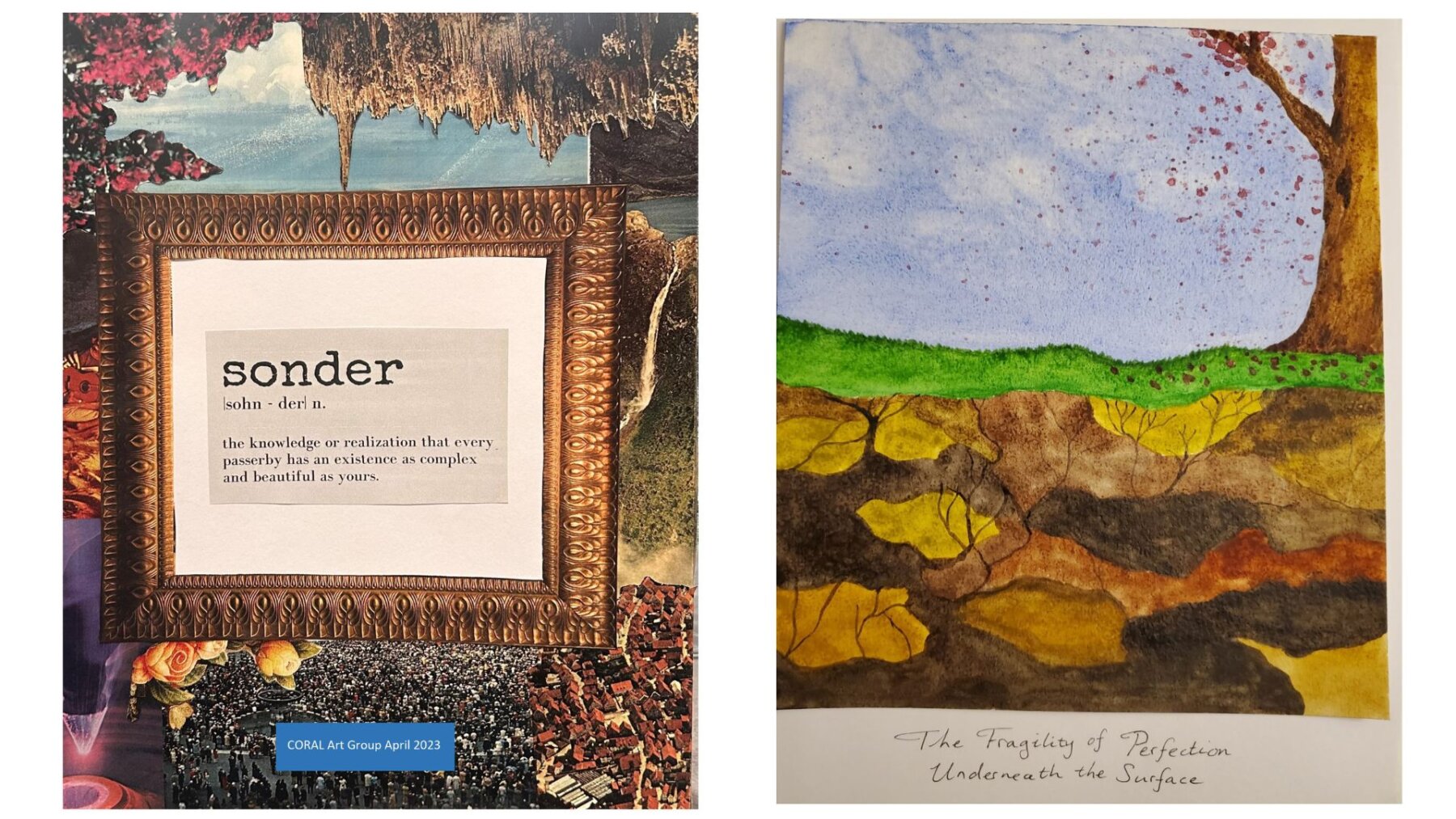
Coss said that because health care workers are trained to quietly soldier on, they can be afraid to open up and be seen as less competent. But she said the facilitators drew vulnerability out of her. “It’s sneaky how it works,” she said. “They tell you, ‘Think about this song,’ or, ‘Try this writing technique,’ and you start to talk about hard things without knowing you’re talking about them.”
Lara Jacobs, CORAL’s writing facilitator, said her strategy is exactly that: to give people the tangible tools to tell their stories. Instead of having them focus on the “what” of the actual trauma, which can be triggering, she gives them prompts and structures like a fragmented essay or writing on notecards to focus on “how” they’d like to express what they’ve gone through. In her eyes, what makes a good writer has a lot in common with what makes a good caregiver: a love of humanity and an attunement to people.
“I’m treating people seriously and with dignity as the writers they are,” Jacobs said.
The program’s unintended benefits
Health care burnout rates remain high across the country due to long shifts, hospital understaffing and PTSD from the pandemic. A 2023 survey of over 18,000 registered nurses found that the percentage of those who are often emotionally drained increased from 62% in 2021 to 77% in 2023. Over two-thirds reported feeling burned out, and only 1 in 4 nurses said their hospitals supported a culture of workforce wellness.
Moss and his research team were quick to admit that CORAL doesn’t have the power to fix broken hospital systems that often overwork and undervalue their staff. The change is supposed to happen within the person — by giving them the confidence and creativity to work through trauma. “They might not be able to change hierarchies and the ways that large health care systems work, but they can change the way that they use creativity to process life experiences,” Henry said.
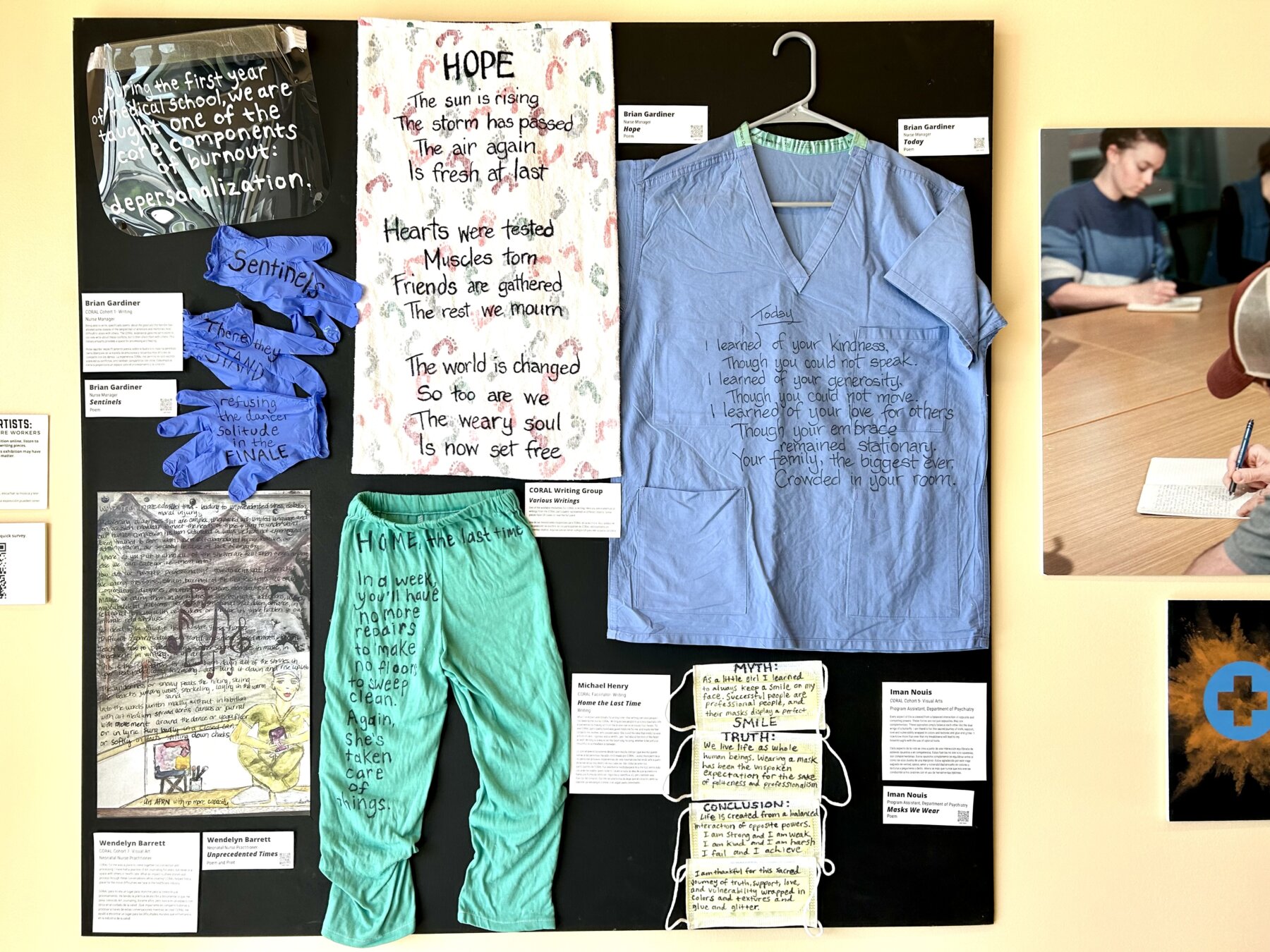
The hope is that the tools learned over the 12 weeks will empower them to make lifelong transformations. Follow-up studies found that CORAL’s reductions in anxiety, depression, PTSD and burnout stuck for the participants even after a year, which Moss said is remarkable for a behavioral intervention program. “Think of weight loss, smoking or drinking intervention, where some or most people regress afterward,” he said. “CORAL equips people with the skills to incorporate lifestyle changes and to view their work differently.”
Other unintended benefits include friendships made across the sprawling hospital network, including staff members they might have never interacted with, as well as an increased empathy for people in different roles. Messinger said that as the only physician in a group full of nurses, she was worried that the hospital hierarchy would prevent the group from being open with her. Her fear turned out to be unfounded. “We had such a rich connection to share across our various experiences, and I got to develop relationships with people outside of our roles at the hospital,” Messinger said.
Gathering a diverse cross-section of hospital workers has also provided an opportunity to discuss workplace racism. Jennifer Jung, a pediatric ophthalmologist, said she was the only Asian participant in her spring 2023 group. When she was prompted to create something vulnerable that she was afraid of showing, she unearthed years of microaggressions — like fielding comments about her “flat” nose, being called “ching ching chong” or being asked her thoughts on Covid’s origins — into a collage titled “Wildflower.” “It was very cathartic to validate that what I’d felt was real,” Jung said. “Most people were shocked that these things had been said to me at their own hospital.”
Jung’s and her classmates’ artwork is now on display at the Lighthouse Writers Workshop and will travel to the state Capitol this summer. When she saw her work at the exhibit, she said she initially felt like she was taking up too much space, but realized that was the very feeling she was trying to combat in her piece. “How does it feel to live unapologetically? It is an unfinished quest for me, but I hope to see myself as a wildflower and let myself bloom where I am,” she said. “I no longer feel so alone on this journey.”
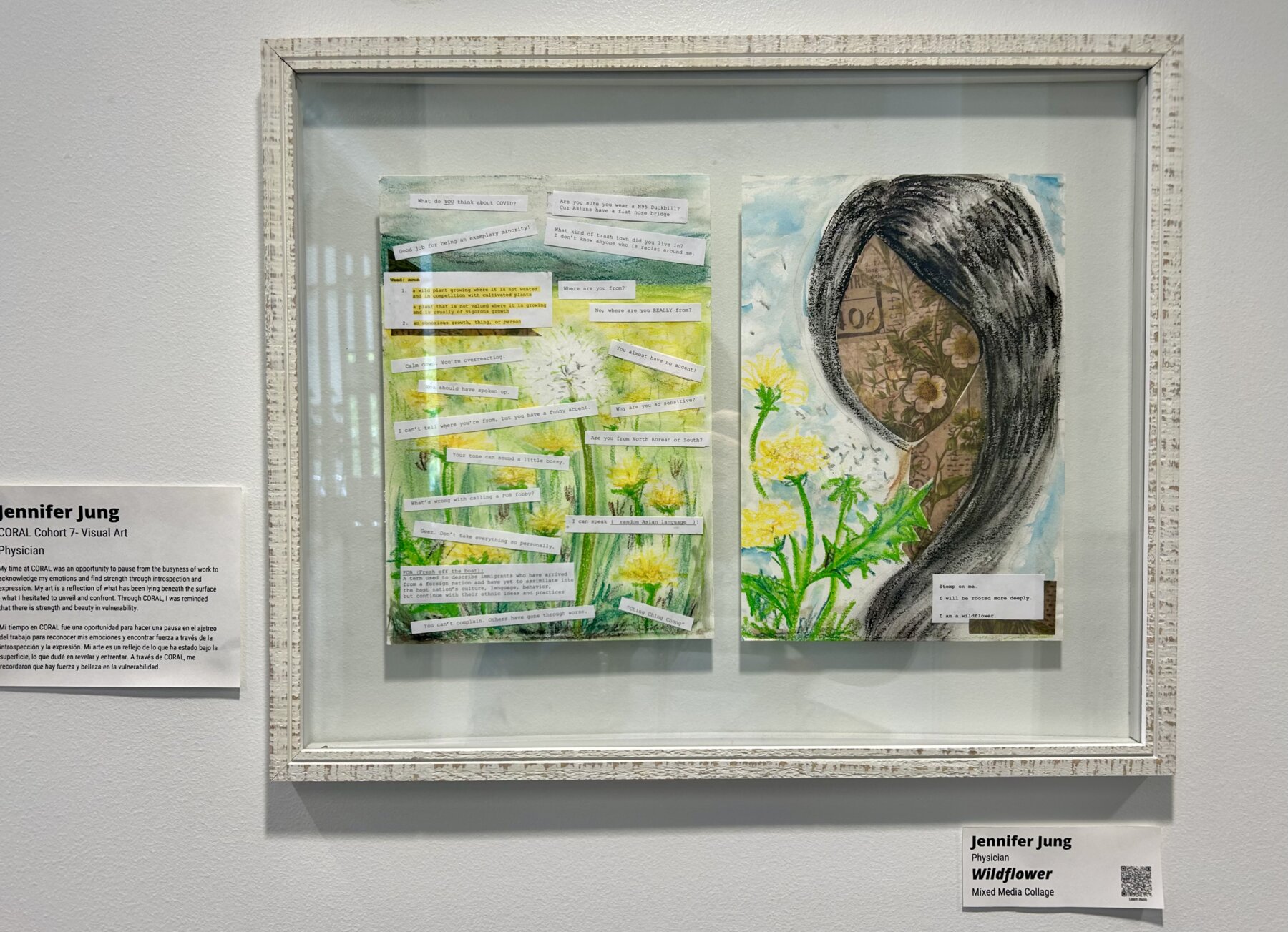
CORAL is waiting to hear back about funding from the National Institutes of Health that would allow it to expand its program outside of Colorado. Researchers’ long-term goal is to replicate CORAL to treat other professions with high turnover, stress and trauma, like teachers, crime scene investigators and first responders. “I fully believe that if we as health care professionals can address the mental health issues in our profession, we can destigmatize the mental health issues for our society at large,” Moss said. “But for now, we’re going to stay focused on health care, because we have a lot of ground to gain for our own industry.”
One year out from her CORAL class, Jung recognizes that she needs to set aside time to express herself through art and draw boundaries to be a better physician. She said doctors have a drive to help others, even if that means sacrificing their own well-being. But she realizes she needs to set limits on how much of herself she gives to her work. “After CORAL, I was reminded that it’s not altruistic to postpone my self-care,” Jung said. “I was reminded that in order for me to pour, I need to be filled, and expressing myself through art is one way that I can fill myself.”
If you or someone you know is in crisis, call 988 to reach the Suicide and Crisis Lifeline. You can also call the network, previously known as the National Suicide Prevention Lifeline, at 800-273-8255, text HOME to 741741 or visit SpeakingOfSuicide.com/resources for additional resources.


